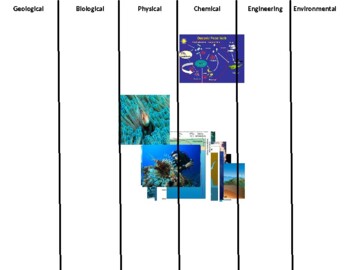Have you ever gazed at the vast expanse of the ocean, mesmerized by its seemingly endless blue horizon, and wondered about the secrets it holds? The ocean, covering over 70% of our planet, is a world of its own, teeming with life, swirling with currents, and shaping our climate. To understand this complex and dynamic environment, scientists have divided the study of the ocean into four distinct branches – the four pillars of oceanography.

Image: slideplayer.com
Oceanography, the interdisciplinary study of the ocean, is a fascinating field that draws on knowledge from biology, chemistry, physics, and geology to unravel the mysteries of our planet’s largest water body. Understanding the ocean is crucial for our survival as it plays a vital role in regulating our climate, providing food security, and supporting diverse ecosystems. Let’s embark on a journey to explore these four branches of oceanography – each a distinct world of wonder, discovery, and vital insights.
1. Physical Oceanography: Unraveling the Ocean’s Movements
The Symphony of Currents
Imagine the ocean as a vast orchestra, with currents playing the melody and waves providing the rhythmic beats. Physical oceanography, the study of the physical properties of the ocean, delves into this symphony. It explores the movement of water – the currents that transport heat, nutrients, and marine life across the globe, shaping our planet’s climate.
From Surface Waves to Deep Ocean Currents
Physical oceanographers study the forces that drive ocean currents, like the wind, the Earth’s rotation, and variations in water density. They investigate the intricate patterns of surface waves, the powerful forces of tides, and the deep-water currents that flow for thousands of kilometers. Their work helps us understand the impact of climate change on ocean circulation, predict extreme weather events like hurricanes, and manage coastal resources.

Image: www.teacherspayteachers.com
Real-World Applications
The knowledge gained from physical oceanography has profound practical implications. It helps us design safer and more efficient ships, understand the movement of pollutants in the ocean, and predict the behavior of marine organisms. By understanding the ocean’s movements, we can better manage marine ecosystems and protect them from human impact.
2. Chemical Oceanography: The Chemistry of the Ocean’s Waters
The Ocean’s Chemical Cocktail
The ocean is not just water; it’s a complex mixture of dissolved salts, gases, nutrients, and pollutants. Chemical oceanography delves into the composition of seawater, investigating the chemical processes that occur within it. It’s like studying the chemistry of a vast, ever-changing laboratory.
Essential Elements and Their Roles
Chemical oceanographers study the abundance of elements like carbon, nitrogen, oxygen, and phosphorus, understanding their roles in marine ecosystems. They investigate the sources and sinks of these elements, revealing how the ocean is involved in the global carbon cycle and the production of oxygen.
Environmental Challenges and Solutions
Chemical oceanography plays a crucial role in addressing global environmental challenges. It helps us understand the impact of pollution on marine life, investigate the causes of ocean acidification, and develop solutions to mitigate these issues. By understanding the chemical processes happening in the ocean, we can better manage its health and our own well-being.
3. Geological Oceanography: The Ocean’s Floor and Its Secrets
A Journey into the Depths
Have you ever wondered what lies beneath the ocean’s surface? Geological oceanography focuses on the structure, composition, and processes that shape the ocean floor, from towering underwater mountains to deep trenches filled with mysterious creatures. It’s like exploring an alien landscape, full of hidden wonders.
Unveiling the Ocean’s History
Geological oceanographers study the formation of ocean basins, the movement of tectonic plates, and the processes that create underwater volcanoes, hydrothermal vents, and submarine canyons. They analyze sediment cores, revealing the history of climate change, past marine life, and the evolution of the ocean itself.
Finding Natural Resources and Understanding Earth’s History
Geological oceanography plays a substantial role in our understanding of Earth’s history and natural resources. It helps us locate oil and gas deposits, discover new mineral resources, and predict the occurrence of earthquakes and tsunamis. By understanding the ocean’s geology, we gain invaluable insights into our planet and prepare for future challenges.
4. Biological Oceanography: Life in the Ocean’s Vast Realm
A Diverse and Thriving World
The ocean is teeming with life, from microscopic plankton to giant whales. Biological oceanography is the study of marine organisms, their interactions with each other, and their relationship with their environment. It’s a world of incredible diversity and fascinating adaptations.
From Plankton to Whales
Biological oceanographers study the distribution and abundance of marine organisms, the food webs that connect them, and the factors that influence their populations. They investigate the role of phytoplankton in the global carbon cycle, the impact of overfishing on marine ecosystems, and the conservation of endangered species.
Solving Problems and Protecting Marine Life
Biological oceanography is essential for sustainable fisheries management, protecting marine biodiversity, understanding the impacts of climate change on marine ecosystems, and developing solutions to threats like pollution and invasive species. By understanding the ocean’s life, we can better protect it for future generations.
What Are The 4 Branches Of Oceanography
Conclusion
The four branches of oceanography – physical, chemical, geological, and biological – weave a complex yet beautiful tapestry of knowledge. Each branch contributes essential insights into the ocean’s intricate workings, allowing us to understand its significance for our planet, ourselves, and our future. Next time you stand on the shore, take a moment to appreciate the vast and fascinating world beneath the surface. This knowledge, gained through oceanography, is a testament to humanity’s thirst for exploration and understanding. So, delve into the depths, explore these four branches, and unlock the secrets that lie within the ocean’s embrace.





